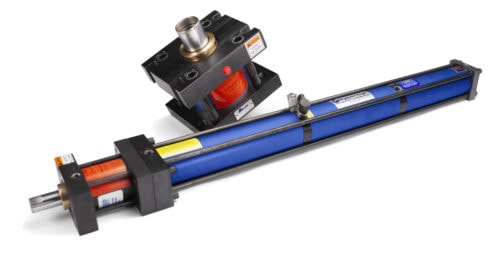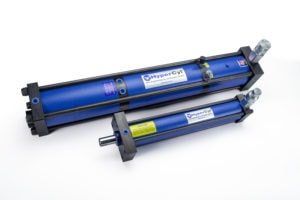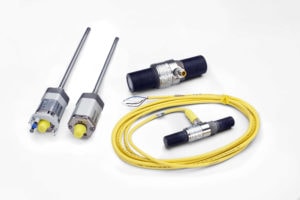Hydra-pneumatic cylinders—commonly referred to in the industry as hydro-pneumatic cylinders, air-over-oil cylinders, or intensifier cylinders—are pneumatically controlled cylinders engineered to generate higher hydraulic pressures to achieve a greater stroke force than can be attained by solely pneumatic cylinders of the same bore size. For example, a 5-inch bore pneumatic cylinder can output less than 1 ton of force at 100 psi, while a 5-inch bore hydra-pneumatic cylinder can produce up to 10, 15, or 20 tons of force, depending on the design.
The following blog post provides an overview of hydra-pneumatic cylinders, including how they work, key features, typical applications, and solutions at HyperCyl.
How Do Hydra-Pneumatic Cylinders Work?
 In contrast to strictly pneumatic or strictly hydraulic cylinders, these hybrid cylinders rely on the surface area differential of an internal pneumatic piston-rod assembly to significantly increase the pressure of trapped oil above the work piston, to provide an intensified hydraulic cylinder output force. Initially, they function similarly to pneumatic, double-acting cylinders, extending and retracting to the workpiece with output forces typical of pneumatic cylinders. However, once in contact with the workpiece, a second pneumatically controlled cylinder section drives a rod into the oil section, sealing it off, and intensifying the internal pressure. The intensified oil pressure pushes against the work piston, producing an increased output thrust, typical of hydraulic cylinders.
In contrast to strictly pneumatic or strictly hydraulic cylinders, these hybrid cylinders rely on the surface area differential of an internal pneumatic piston-rod assembly to significantly increase the pressure of trapped oil above the work piston, to provide an intensified hydraulic cylinder output force. Initially, they function similarly to pneumatic, double-acting cylinders, extending and retracting to the workpiece with output forces typical of pneumatic cylinders. However, once in contact with the workpiece, a second pneumatically controlled cylinder section drives a rod into the oil section, sealing it off, and intensifying the internal pressure. The intensified oil pressure pushes against the work piston, producing an increased output thrust, typical of hydraulic cylinders.
Similar to other double-acting pneumatic cylinders, hydra-pneumatic cylinders utilize valves to control their motion. They have one four-way valve to control approach and retract motion, and one four-way valve to control oil pressure intensification. This design combines the advantages of pneumatic and hydraulic cylinders without any of the disadvantages (e.g., excess heat and noise, space limits, or risk of leaks). Compared to strictly pneumatic cylinders with a multi-stage design, these cylinders consume only about 1/4 to 1/3 of the air.
Key Features of Hydra-Pneumatic Cylinders
While hydra-pneumatic cylinders come in a variety of designs to suit different applications, some of their key features include:
 Three major moving components
Three major moving components- Simple control circuits
- Total/air oil separation on both sides of the oil
- Wear bands on the reservoir and work pistons
- Linear output forces up to 200 tons
- Heavy-duty construction for durability and reliability
- Tie rods with tensile strengths of 100,000 psi
- Mean time between failure (MTBF) of 4.7 million strokes
- Service life of 20 million strokes
- Operational capacities in any position or attitude
- Medium-duty mounting styles compliant with National Fluid Power Association (NFPA)
- Included repair manual and field serviceable seal kits
- Options for gage kits, sensors, total stroke limiters, alignment couplers, and more
Typical Industry Applications for Hydra-Pneumatic Cylinders
 The full line (six series) of HyperCyl® hydra-pneumatic cylinders are designed for machine builders and OEMs to use in their own presses and automation, as well as for use in HyperCyl supplied presses. HyperCyl presses are available with “C” frames or “H” frames, unguided, two-column guided, or four-column guided upper bolsters, and bench-mounted, pedestal, or machine base configurations. Due to their modular design, machine designers can choose a simple frame and drive unit design that facilitates integration into a larger assembly process, or a turnkey design that incorporates automation technology, controls, and more.
The full line (six series) of HyperCyl® hydra-pneumatic cylinders are designed for machine builders and OEMs to use in their own presses and automation, as well as for use in HyperCyl supplied presses. HyperCyl presses are available with “C” frames or “H” frames, unguided, two-column guided, or four-column guided upper bolsters, and bench-mounted, pedestal, or machine base configurations. Due to their modular design, machine designers can choose a simple frame and drive unit design that facilitates integration into a larger assembly process, or a turnkey design that incorporates automation technology, controls, and more.
HyperCyl presses find use in a wide range of production applications, such as:
- Part insertion and assembly
- Material piercing
- Clinching
- Staking
- Drawing
- Marking
- Cutting
- Pressing
- Folding
- Riveting
Why Partner With HyperCyl for Your Hydra-Pneumatic Cylinder Needs?
HyperCyl by Aries Engineering Company (AEC) is a privately owned company based in Dundee, Michigan. We specialize in the manufacture of hydra-pneumatic cylinders and presses for assembly, piercing, and forming applications. By utilizing our cylinders, our customers benefit from the following:
- Greater Process Control: Our cylinders allow for separate regulation of the approach stroke and power stroke, which allows for more complete control over the process without the need for cylinder reconfiguration.
- Higher Retract Force: Since our cylinders generate greater retract forces, they can accommodate the attachment of heavier tooling.
- No Stored Energy: Our cylinders do not use mechanical springs to move the pistons, which can break and hinder/halt operations. There are no unexpected motions from stored energy in HyperCyl cylinders.
- Better Cost Savings: Our cylinders consume less air than other pneumatic cylinders. Our cylinders take up less space, generate less heat and noise, and cost less to purchase than a hydraulic cylinder and power unit. Additionally, they offer faster operational speeds and a smaller risk of leakage.
All of these qualities translate to lower investment, operational, and/or maintenance costs.
Source Hydra-Pneumatic Cylinders from HyperCyl
Since 1994, we’ve helped our customers determine the force and stroke requirements for their applications to help them design and purchase the right equipment for their needs. By evaluating their parts with our in-house equipment, we help identify the forces needed, and which actuator is best suited for their assembly, piercing, or forming application. All supplied materials are accompanied by complete evaluation documentation and reporting. We also offer access to an extensive database of hundreds of previous assembly and forming applications for examples of our capabilities.
To learn more about our product solutions and how they can benefit your assembly or forming application, contact us today. To discuss your application requirements with one of our experts, request a quote.


Comments are closed